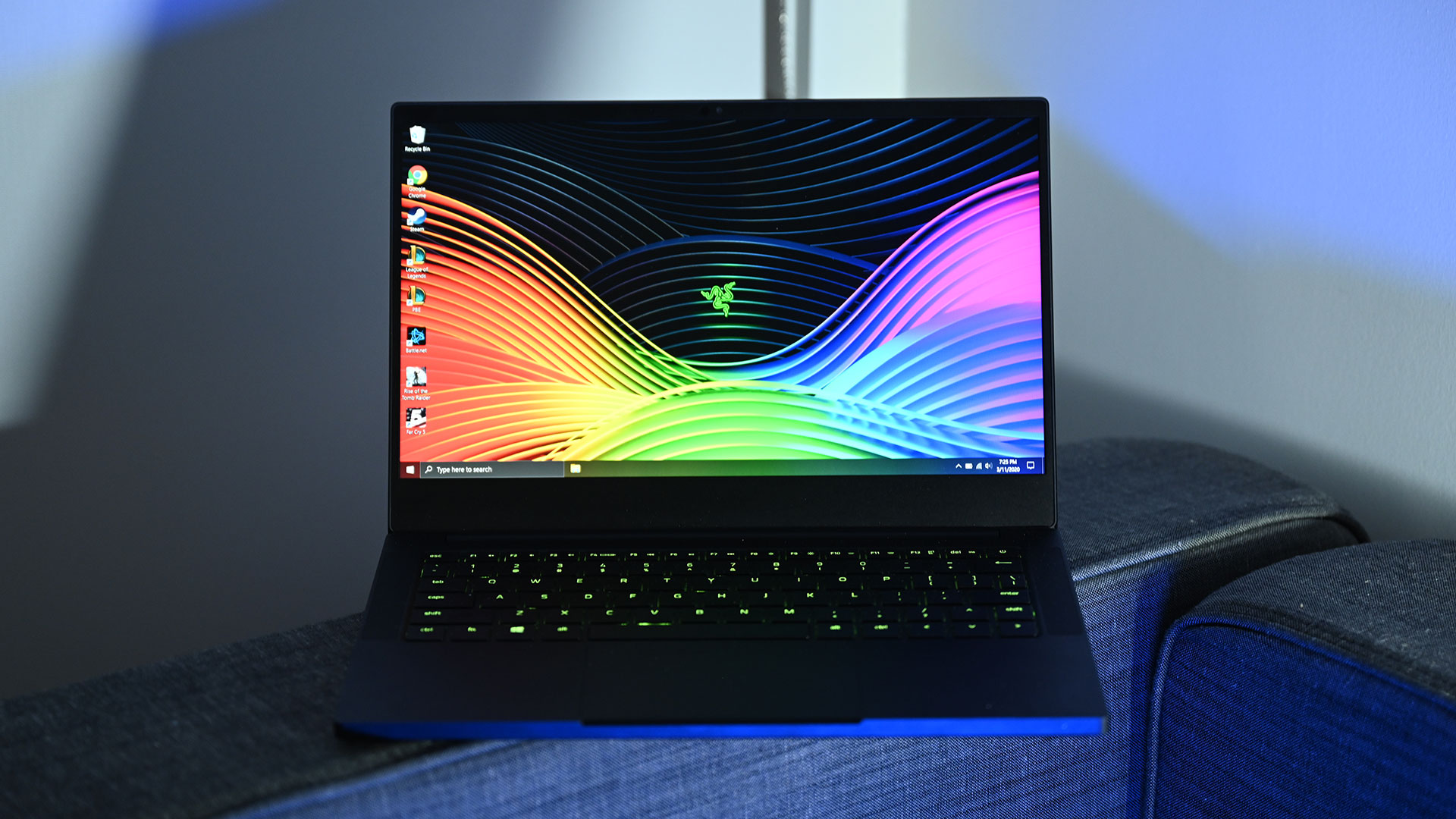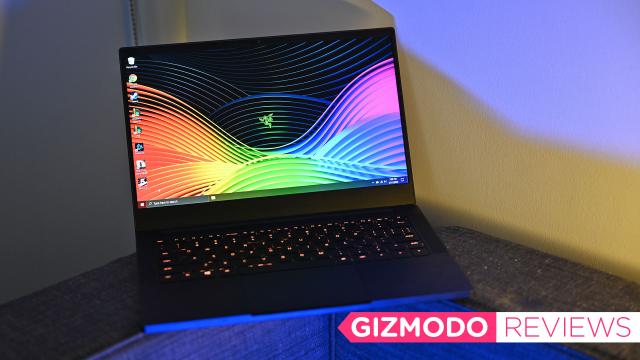My first gaming laptop, which I bought more than 15 years ago, was a 10-pound, 17-inch beast so big and heavy I only really moved it around when travelling back and forth between home and college. I eventually upgraded to a 15-inch laptop that was a little easier to carry around, but because its case and cooling couldn’t handle the desktop-class CPU inside, the thing constantly overheated and burnt out after just a year. Ever since, I’ve been on a quest to find a do-it-all machine good for gaming, editing, and everything else I need, while still being portable enough that I never feel stressed about carrying it around. With the latest Razer Blade Stealth, my search has ended.
Featuring a sleek, minimalist chassis made from CNC milled aluminium and a 13.3-inch display, the Razer Blade Stealth (12 x 8.27 x 0.58-inches and 2.82 pounds) is essentially the same size and a touch lighter than 13-inch MacBook Pro (11.97 x 8.36 x 0.59-inches and 3.02 pounds). But what separates the Blade Stealth from the MBP is that while both systems start out with integrated graphics, only the Stealth has an optional discrete GPU in the form of Nvidia GTX 1650 graphics. That makes all the difference, because finding a 13-inch laptop with discrete graphics is a rare thing. Companies like Alienware gave up making 13-inch gaming laptops a few years back, and most others never even tried. But for me, a 13-inch laptop that you can actually game on is like running into a unicorn.

Razer Blade Stealth
What is it?
A 13-inch laptop with an optional GTX 1650 GPU
Price
Starts at $2,449 ($2,849 as reviewed)
Like
Excellent build quality, slick design, four USB ports, optional GTX graphics, big touchpad
Don't Like
Awkward keyboard layout, somewhat expensive, touchscreen only available on the 4k display, case can get a bit toasty under full load
Now there is one major caveat to all this: While the Blade Stealth starts at just $2,449, the base config that comes with that GTX 1650 GPU costs $2,849. And if you want a touchscreen, you’ll have to upgrade to Razer’s 4K display. (That said, at the time of writing, a Blade Stealth with an Nvidia GPU and 4K display actually costs about $150 less than the model with a full HD display and Nvidia graphics.) That ain’t cheap by any means, but if you regularly use your laptop for both work and play, it’s not a totally outlandish price.
But the thing that impressed me the most was comparing benchmark numbers between the Blade Stealth and the XPS 15 I tested late last year. In Rise of the Tomb Raider at 1920 x 1080 and high graphics, the Blade Stealth actually slightly outperformed the XPS 15, posting an average frame rate of 60.7 fps compared to 54.2 fps for the Dell. Numbers were closer in Far Cry 5 at 1920 x 1080 on high, with the Blade Stealth and XPS 15 posting average frame rates of 48 fps and 49 fps respectively.
In more productivity-focused tests, such as rendering an image in Blender, the Intel Core i7-1065G7-powered Blade Stealth started to fall behind. It took 17 minutes and 22 seconds to complete the task, versus just 6:29 for the XPS, though that’s mostly due to the XPS 15’s much more powerful Core i9 CPU having four more cores and eight more threads. But the real equaliser for the Razer is that the XPS 15 is a much bigger system that costs $4,199 for the same GPU and same overall gaming performance—and the Razer is a lot easier to carry around.
When you look past its performance, the Blade Stealth is tops across the board. Its build quality is excellent, almost bordering on sharp for anyone used to the more rounded edges found on a MacBook Pro. You also get a headphone jack and a total of four USB ports (one USB-A and one USB-C with Thunderbolt 3 on each side), with both USB-C ports also capable of handling recharging duties using the system’s including USB-C power adaptor.
The touchpad on the Blade Stealth is huge, spanning from the bottom of the keyboard to the edge of the laptop, and Razer’s RGB lighting gives the Stealth one of the best-looking and most colourful keyboards in the business (though you don’t get per-key RGB lighting like you do on Razer’s bigger gaming laptops).
The Blade Stealth isn’t perfect. In order to accommodate a set of full-size arrows keys, the right side of the Stealth’s keyboard is a bit cramped, with a half-sized Shift key and shrunken Backslash, Enter, and Backspace keys. This can take some getting used to, especially if you’re like me and you use Right Shift for typing—Left Shift is often used for things like crouching or sprinting in FPS games.
Aesthetically, the one thing I’d really like to see Razer do is slim down the Stealth’s bottom bezel. Functionally, it’s not really an issue, but when compared to a lot of other laptops like the XPS 13, that big chin just looks excessively chunky. Another negative: With two big fans on the bottom of the system, the Stealth can get toasty under full load.
A lot of other laptop makers have started putting more vents in the rear or sides to combat this, and the Stealth has some vents in back, too, but it’s not enough to prevent the Stealth from getting a bit too hot to really game with on your lap.
Thankfully, when it comes to battery life, the Blade Stealth performs quite well compared to a standard gaming laptop. The machine lasted 8 hours and 9 minutes on our video rundown test, which is about an hour less than an XPS 13 with a 4K display (9:26), but almost twice the longevity of something like HP’s 15-inch Omen 2 XS (4:14). If you’re actually gaming on the go, you’re looking at closer to four hours on a charge—maybe less, depending on the game.
The Razer Blade Stealth brings to mind the age-old camera adage: The best camera is the one you have with you. While I admire all the outrageous 15- and 17-inch systems with desktop-class parts, I don’t want to carry them around and will often choose a more portable ultrabook laptop instead. But with the Stealth, I find myself looking for excuses to drop it in a bag and work on the move, because I know that when I’m done with the job, the Stealth has the power to let me get some gaming in, too.
README
-
Razer is one of the only laptop makers putting discrete GPUs in 13-inch laptops, and while it’s not cheap, for people who want a portable gaming notebook that won’t break their backs, it’s worth it.
-
For a gaming laptop, the Stealth’s battery life is surprisingly decent.
-
The right side of the Stealth’s keyboard feels cramped and can take longer than usual to adjust to.
-
The Blade Stealth supports Windows Hello face login but not fingerprint login, as materials on Razer’s site might suggest, which apparently is a Windows marketing thing.
